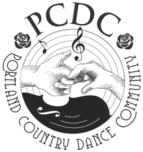by Kathy Story
I love to swing during a contra dance! My favorite dances have both a partner and a neighbor swing. I love to swing fast. And when I’m dancing the Robin role, I love to spin out of it with a big flourish. But I know not everyone enjoys all that, so I always check in with my partner: Do you like to swing quickly? Are you okay with swinging somewhat close? Do you like flourishes?
But no matter how you like to swing—walk-around or buzz step, fast or slow, close or not, flourish or no flourish—one thing is always the same: you need to support yourself and you need to support your partner! When you do that, swings are so much more satisfying, comfortable, and actually safer for both dancers.
So just how do you do that?
Let’s begin with the dancer’s frame, that powerful upper body position in which you can feel the air pushing up from below your arms and energy flowing from the middle of your back right out your fingertips. Can’t quite visualize that? Then consider these points:
Larks: Your right arm gives your partner support when you place your flat hand (no claws please) on or just below the Robin’s left shoulder blade (or as close as you can get). Your hand should not go past the center of the Robin’s back: this restricts movement and can be too close for comfort. And it should not be placed high on the shoulder or inches below the shoulder blade: neither of these hand positions give support and the latter can actually hurt the Robin’s back. Ouch! (And frankly, it feels a little bit creepy.) Hold that right arm in a strong way—if someone came over and pushed down on it or tried to pull it away from the Robin’s shoulder blade, there should be some resistance. The height of your elbow depends on your relative heights.
Robins: Your left arm is just as important for supporting you and your partner as the Lark’s right arm. Don’t do the dreaded “hang-on,” where you grab their arm and pull down to hold yourself up, or the equally awful “pinch,” where you push down so hard with your arm that it pins the Lark’s arm to their side. When I’m Larking and my partner swings like this, my arms and shoulders ache by the end of the dance. Ouch again! Instead, support the Lark by placing your hand on their back as high as you can reach. Then keep your elbow lifted and hold up your upper body with your own strength.
When you both support each other, there’s no need for either dancer to lean backwards—another thing that makes my arms and shoulders ache when I’m dancing either role.
All of this depends upon the relative height, proportions, strength, and experience of each dancer, as well as any injuries. It’s helpful to practice a swing or two when you line up before the caller begins the walk-through. It’s easier to figure out the most comfortable position for your swings then, rather than during the frenzied madness of the dance.
Please, no bouncing, hopping, or skipping during a swing! Even a buzz step makes for a smooth swing. If you want to flourish at the end of a swing, do not crank the Robin’s arm—another ouch! The Robin should be directly under the Lark’s arm, not having to lean backwards, and the Lark should guide the Robin to turn without gripping the Robin’s hand.
Do pay attention to timing. If there’s not enough time for a flourish for the Robin, don’t attempt it. Otherwise, the Robin will be late for their next move, throwing off the timing for your group of four, and maybe the entire line. Of course, even if there’s time, the Robin can refuse the flourish by not lifting their arm.
So why should you care? We all want to have a great dancing experience and we want to do it with as little effort (and pain!) as possible. We also want folks to dance with us—to actually look forward to dancing with us. No Lark wants to feel like they’re dragging the Robin around in a swing, and no Robin wants to feel like their back is in jeopardy. Neither dancer should be doing all the heavy lifting. When a Lark doesn’t support me, I politely request their hand be moved into the proper position to do so. If they don’t understand, I ask if I can take their hand and put it where I need it so that I don’t get hurt. If they don’t honor my request, I might avoid dancing with that Lark again to protect myself. When a Robin doesn’t support me, and hangs on or pinches my arm, I politely ask them to hold themselves up and give me a little support. If they don’t understand, I try to show them what I need. If they don’t honor my request, I might avoid dancing with that Robin again to protect myself.
When we gently give and take feedback with each other, we become better dancers for every partner. When both dancers support themselves and their partner, there is magic: effortless and satisfying swings. What could be more fun?!
